By Phil Norris January 23, 2024
Sending email newsletters is widely recognized as one of the most effective ways to reach, engage, and convert your audience, with over 90% of marketing professionals describing email marketing as at least somewhat critical to business success.
So it’s no surprise that the vast majority of brands send email campaigns at least merienda per week:

To keep your audience engaged and make your content renombrado, you need to choose a newsletter software tool that makes it easy to design beautiful, high-engagement emails that land where you want them to: in the main inbox.
But with hundreds of newsletter platforms to choose from, it’s hard to know where to start.
That’s why we’ve done the research for you and compiled our list of the nine best newsletter software platforms, highlighting their:
- User reviews
- Key features
- Free functionality
- Technical support
- Pricing
And we’ve even provided practical tips for choosing your ideal newsletter software tool.
Let’s get into it…
How to choose the best email newsletter software: What to look for
The overall best email newsletter platform for you will naturally depend on your own specific requirements. But the vast majority of content creators, coaches, online marketplace sellers, and small businesses should prioritize tools that offer the following features:
High email deliverability
When you send emails to your friends, family, and colleagues from your personal or business account, you can feel pretty confident they’ll reach their intended destination.
This is because you’ve got a history of back-and-forth conversations.
But this may not be the case when you’re sending your newsletter, so you’ll definitely want a tool that enables high email deliverability.
Many newsletter software platforms shout about their sky-high email delivery, but that doesn’t guarantee your newsletters will actually be seen.
Why?
Because email delivery isn’t the same as email deliverability; those six extra letters make a whole world of difference:
- Email delivery is whether the receiving mail server accepted the email and delivered it to the mailbox, regardless of which folder it lands in.
- Email deliverability is whether the email is placed in the recipient’s primary inbox.

In other words, even if a tool claims a 99.9% delivery rate, your newsletters could still end up in spam, promotions, updates, or some other folder that never gets checked.
So don’t be swayed by flashy-sounding delivery statistics; find out what they’ll do to maximize your email deliverability.
For instance:
- Do they require a confirmed opt-in email? This simple confirmation helps prevent people from receiving unsolicited newsletters.
- Do they allow people using their platform to import a purchased email list? This is a major red flag that they allow spam to be sent from their newsletter platform.
- Do they adhere to ISP (Internet Service Provider) standards for managing and sending opt-in email?
These are just a few of the proactive measures that help newsletter platforms achieve strong deliverability.
Try-before-you-buy capabilities
Ultimately, the best way to understand if a platform is right for you is to read the reviews and recommendations, make sure it’s got all the right features, then try it yourself.
For that reason, you should look for newsletter software tools that offer a totally free plan, not just a limited-time free trial, so you can navigate the various features and see if it’s a good fit.
A 14-day trial just isn’t enough to really get to grips with a platform.
Easy-to-use email builder
Ideally, you don’t want to pay developers to code your emails and graphic designers to make them look good — you want to do it yourself (even if you don’t have a ton of technical skills).
So we recommend prioritizing platforms with user-friendly email builders, like a drop-and-drop editor for adding and arranging your design.
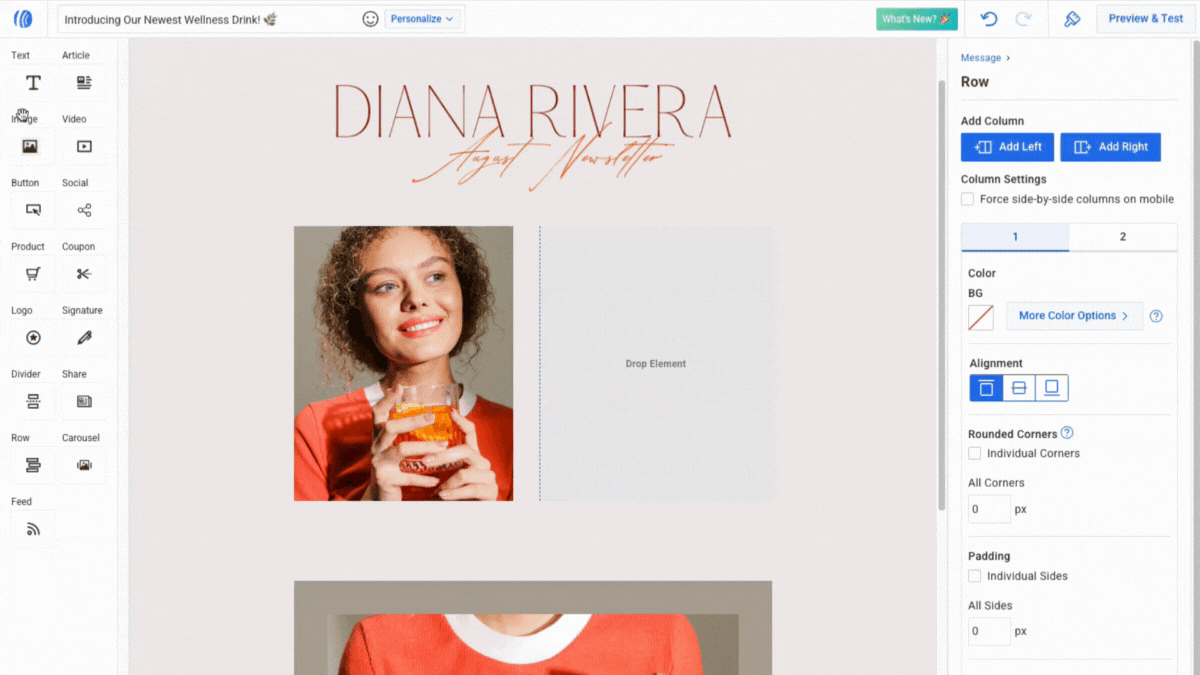
Built-in monetization
Not all email tools have built-in ecommerce functionality.
This is a key consideration, because most people don’t start email newsletters for the sake of it — they do it to make money, whether through…
…or some other tactic.
Whatever your monetization strategy, make sure your chosen newsletter platform supports it.
Time-saving content creation tools
Not everyone is a natural born designer or copywriter.
And even if you are, it’s still nice to have a helping hand when you’re feeling a little uninspired.
That’s why we recommend choosing a newsletter platform that features creative support tools like:
- AI writing aids to help you brainstorm ideas and turn them into engaging copy.
- RSS feeds to add your most recent posts, podcasts, videos, and products in your emails.
- Features that allow you to make quick updates to every aspect of your newsletters.
- Built-in graphic design tools like Canva to add rich images to your emails.
Dynamic segmentation
Pretty much every newsletter platform offers some sort of audience segmentation functionality, which allows you to cut and slice your email list based on shared characteristics and behaviors.
But to really stand out, you want a newsletter platform that enables dynamic segmentation.
Traditional segments are static, which means a customer will remain in a segment until you move them to a new one.
Meanwhile, dynamic segments update in verdadero time based on customer behaviors.
For instance, imagine you run an ecommerce store. If a shopper spends $300 within three months, they could be automatically moved to your dynamic “VIP customer” segment, so you can send them targeted newsletters encouraging them to buy even more.
Tools to grow your audience
Unfortunately, email lists don’t grow by themselves.
You need some way to get people to subscribe through landing pages, sign-up forms, and popups.
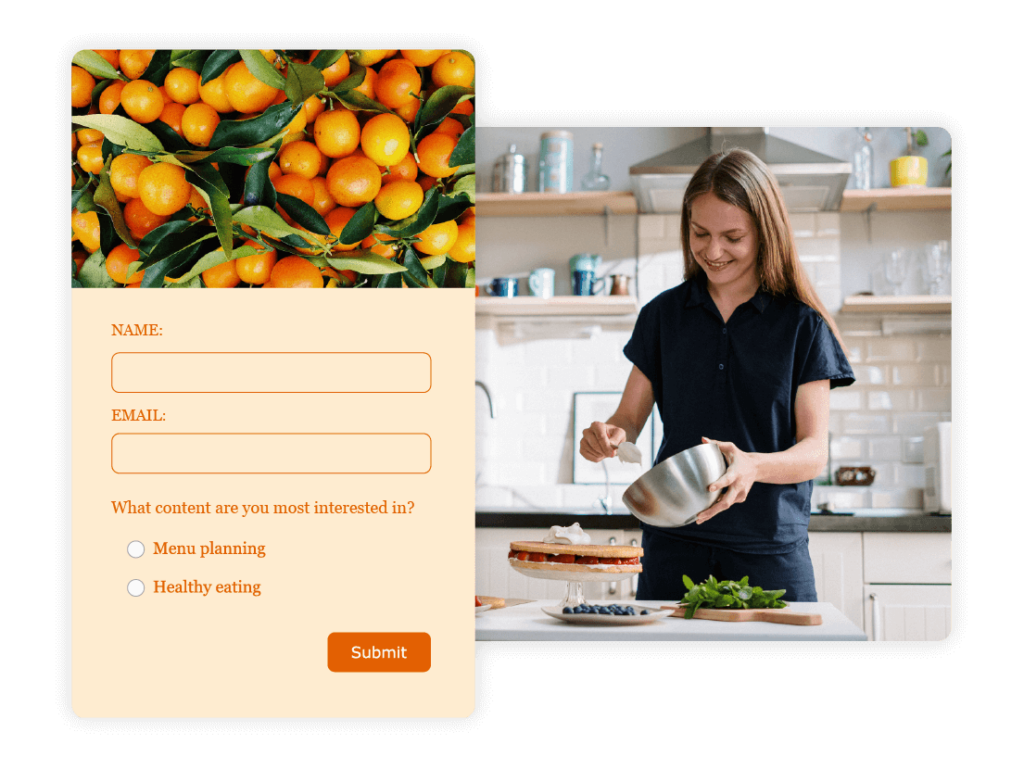
Don’t have your own website?
That’s not necessarily a problem, because some email newsletter platforms will host your form or landing page for you.
9 best newsletter software platforms
Now let’s take a more in-depth look at each platform…
1 – AWeber

Reviews
Best for: All-round newsletter functionality
AWeber is best for people looking for an all-round email newsletter platform that does a bit of everything. Great for coaches, content creators, bloggers, affiliate marketers, and sellers on online marketplaces like Etsy.
Key features
- #1 online graphic design tool, Canva, built directly into the email builder.
- Universal theme settings allows you to change fonts, colors, buttons, dividers, and more from a single control.
- Email automatically sent to subscribers the moment you publish new blogs, videos, products, and more.
- RSS feed that will auto-display titles, descriptions, and images for published content and products.
- Drag-and-drop email builder for easy newsletter customization.
- Signup forms and landing pages to help grow your newsletter list.
- Sales pages and multiple payment options to monetize your newsletter.
- Dynamic content and segmentation let you deliver personalized audience experiences.
- Web push notifications on all plans enable you to reach your audience beyond the inbox.
- In-house email deliverability team with extensive deliverability management and expertise.
- AI writing tool to brainstorm ideas and create draft newsletters in seconds.
- Split-testing allows you to measure which subject line, preview text, message content, and send time variants deliver the best results.
Customer Support
All AWeber users — even those on the free plan — can contact the support team via live chat and email support, while paying customers can also access phone support.
Free functionality
On AWeber’s free plan you can have up to 500 subscribers and send up to 3,000 emails a month. It also offers access to advanced tools, including a landing page builder, lead capture forms, and segmentation.
Pricing
Paid plans start at $12.50 per month for up to 500 subscribers and unlimited emails.
Sign up for an AWeber account today.
2 – Constant Contact
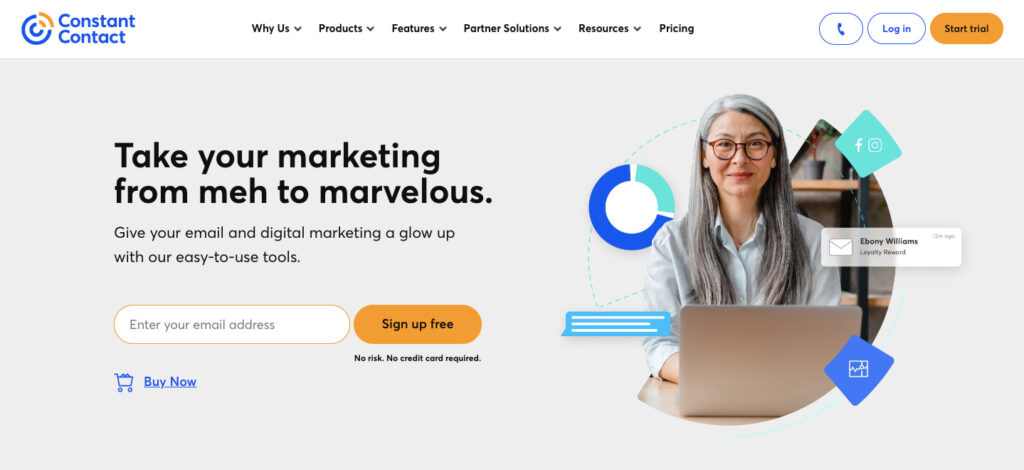
Reviews
Best for: Multichannel marketing
Constant Contact is a good fit for marketers looking to leverage multiple channels — email, SMS, and social media — from within a single platform.
Key features
- AI-powered subject line recommendations.
- Use the drag-and-drop editor or start with one of 200+ templates.
- Personalize your newsletters with dynamic content blocks that update based on who sees them.
- Use the mobile app to manage campaigns from your phone.
- Bolt on SMS messaging to run multichannel marketing campaigns.
- Extend your reach by posting on Facebook, Instagram, and LinkedIn from within the platform.
- Generate leads using the built-in landing page builder.
Technical Support
All Constant Contact customers can access self-service, live chat, and phone-based support, regardless of which plan they’re on. However, they do not offer email support.
Free functionality
Constant Contact doesn’t have a free product tier. Instead, it offers a 60-day free trial with a 100-email send limit.
Pricing
Prices start at $12 per month for up to 500 contacts and 5,000 monthly email sends.
3 – Mailchimp

Reviews
Best for: Advanced newsletter analytics
Data-driven marketers will love Mailchimp’s sophisticated reporting tools, which provide real-time insights on emails, automations, ecommerce performance, and more.
Key features
- Get inspiration for your newsletter design from a library of 100+ pre-built email templates.
- Optimize your newsletter campaigns using advanced analytics and reporting tools that pull in data from multiple platforms, including Google Analytics and Shopify.
- Create quality content faster with generative AI tools, available on Mailchimp’s Standard and Premium plans.
- Build optimized landing pages or even an entire website using the Mailchimp platform.
- Deliver personalized messaging at scale using multichannel automations.
- Integrate with 300+ apps and tools, including QuickBooks, Shopify, and WooCommerce.
Technical Support
Mailchimp’s technical and customer support varies by price plan. Essentials and Standard subscribers get 24/7 email and chat support, while top-tier Premium customers enjoy phone and priority support. On the free plan, users are limited to email support — and only for the first 30 days after they sign up.
Free functionality
Mailchimp’s free plan includes up to 500 subscribers and 1,000 monthly email sends, plus forms, landing pages, and limited access to reporting tools and newsletter templates.
Pricing
Paid plans start at $13 per month for up to 500 subscribers and 5,000 monthly email sends.
4 – MailerLite

Reviews
Best for: Low-cost email marketing
MailerLite is one of the lowest-cost newsletter platforms on the market.
Key features
- Design emails your way using either the drag-and-drop editor, rich text editor, or HTML email editor.
- Gather audience feedback by embedding surveys within your newsletters.
- Add social sharing features to expand your audience.
- Target multiple audiences with a single email by filtering who can see certain content sections.
- Monetize your newsletter by connecting your online store or selling digital products and subscriptions.
- Get a headstart with 50+ professionally designed newsletter templates.
Technical Support
All paying MailerLite customers receive 24/7 email support, while Advanced and Enterprise subscribers also get access to live chat support. If you’ve got a free MailerLite account, you’ll have to make do with up to 30 days of email and chat support.
Free functionality
MailerLite’s free plan allows you to send 12,000 monthly emails to up to 1,000 contacts and also includes access to the platform’s landing page, lead capture form, and automation builders.
Pricing
Paid plans are priced from $10 per month for up to 500 subscribers and unlimited emails.
5 – Flodesk
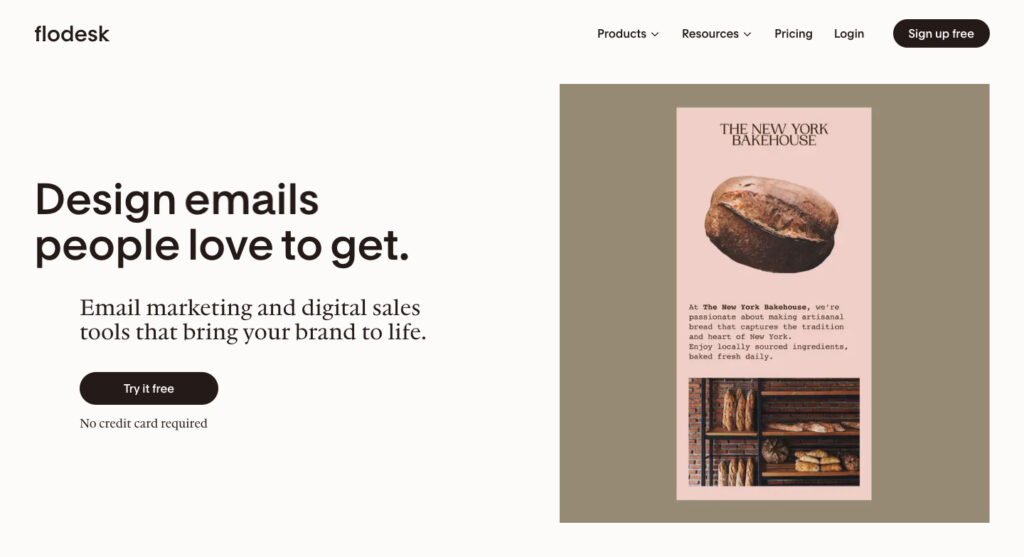
Reviews
Best for: Big newsletter lists with simple needs
Whether you’ve got 100 newsletter subscribers or 100,000, Flodesk charges you the same monthly sum (although there’s an extra cost for ecommerce functionality).
Key features
- Pay one fixed rate, no matter how fast your newsletter grows, with a single price plan for up to 100,000 subscribers.
- Make data-backed decisions by analyzing your most popular emails, sending times, and more.
- Grow your newsletter list by building sign-up forms and landing pages.
- Create on-brand newsletters by uploading your own fonts and branded graphics (although custom fonts aren’t compatible with all email providers).
- Bolt on ecommerce functionality to monetize your content through sales pages, payment processing, and checkout flows.
Technical Support
Flodesk only offers email-based technical support. They answer emails from 6 am to 6 pm ET, typically within two business days.
Free functionality
Flodesk does technically offer a free plan, but it doesn’t include any newsletter-sending functionality — just a free link-in-bio tool for lead generation.
Pricing
To send email newsletters through Flodesk, you’ll need to pay $35 per month (plus a further $24 per month to add ecommerce functionality). The email marketing plan includes up to 100,000 subscribers.
6 – Substack
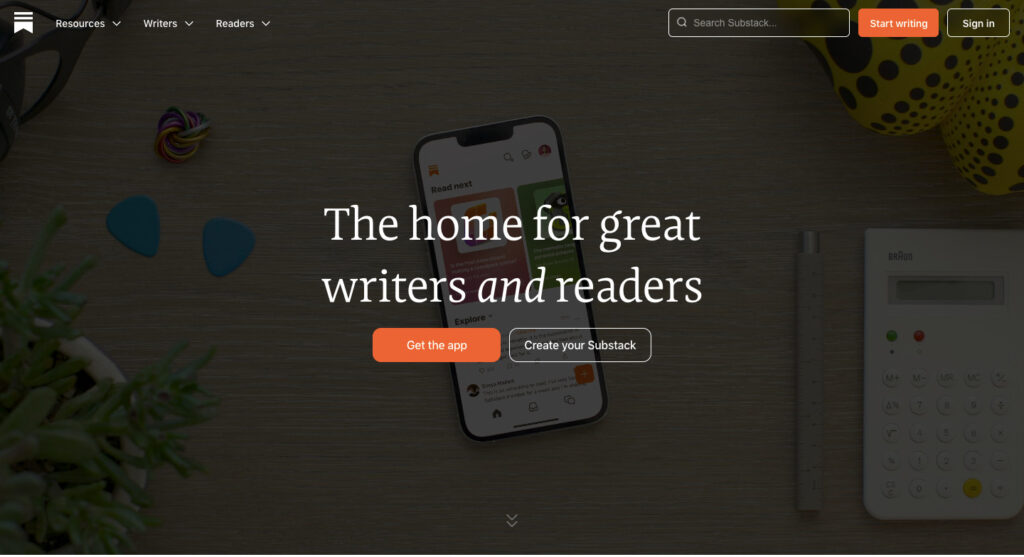
Reviews
Best for: Thought leaders and influencers
If you already have a big audience and are looking to monetize through paid newsletters, Substack could be the perfect newsletter platform. It’s not quiebro as effective if you’re trying to grow an email list from scratch.
Key features
- Monetize your newsletters by charging your readers subscriptions of $5 – $75 per month.
- Send newsletters free of charge; Substack just takes a cut of your subscription fees.
- Switch your existing newsletter to Substack by importing mailing lists and content archives from Medium, Tumblr, WordPress, and other platforms.
- Decide which posts to publish for free and which to keep behind your subscription paywall.
- Grow your audience with in-platform recommendations, guest posts, mentions, and referrals.
Technical Support
You can reach out to Substack’s support team via live chat or by submitting a request through an onsite form.
Free functionality
Substack is totally free for writers; they make their money by charging a percentage of your subscription fees.
Pricing
While you don’t technically pay Substack anything, they keep 10% of your subscription fees. You keep the rest, minus credit card and transaction fees.
7 – ActiveCampaign
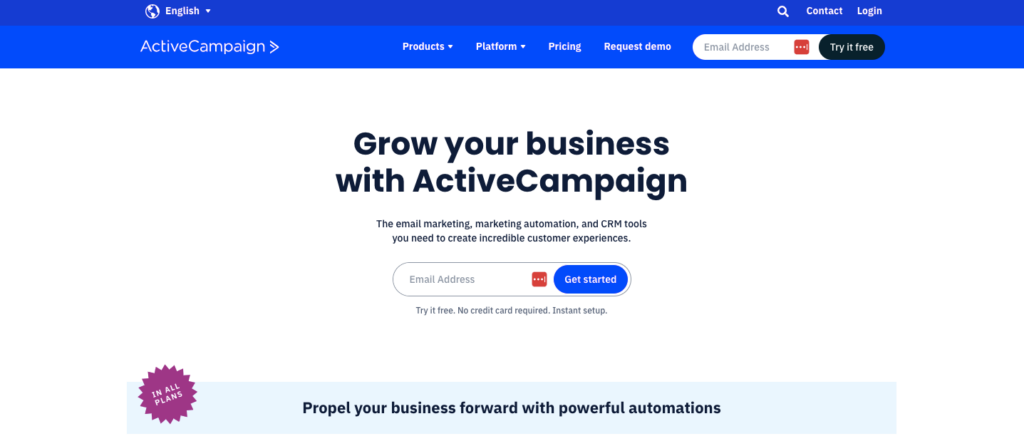
Reviews
Best for: Enterprise-grade email marketing
ActiveCampaign’s sophisticated segmentation tools and multi-user editing functionality make the platform a popular choice for marketing teams at big businesses. Plus it’s comparatively pricey, which might put off individual content creators and smaller teams.
Key features
- Set up beautiful campaigns in minutes using the drag-and-drop email designer.
- Send targeted email campaigns at scale with ActiveCampaign’s segmentation and dynamic content tools.
- Run split tests to understand which newsletters generate the most opens, clicks, and sales.
- Get inspired by hundreds of responsive email templates for B2B and B2C marketers.
- Keep your sender reputation high with automatic list-cleaning to remove inactive contacts.
- Collaborate on newsletter design and campaign setup with multi-user editing.
Technical Support
ActiveCampaign customers can access technical support via live chat or by submitting a request through an onsite submission form.
Free functionality
ActiveCampaign doesn’t have a free plan. Instead, it offers a 14-day free trial that includes access to most — but not all — of the platform’s features.
Pricing
Paid plans are priced from $29 per month for 1,000 contacts and 10,000 monthly email sends.
8 – GetResponse
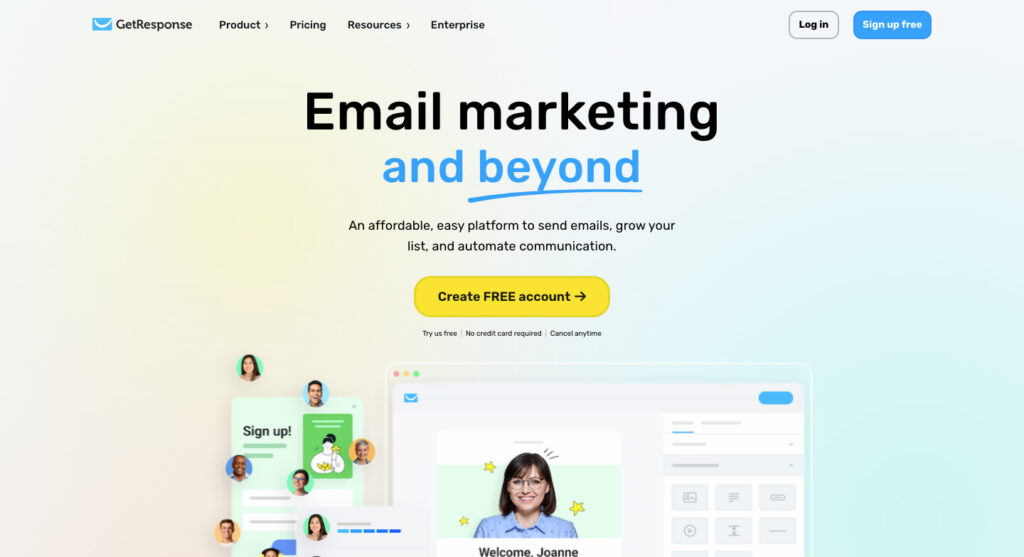
Reviews
Best for: Newsletter insights
If you’re the type of marketer who likes to analyze live data and course-correct fast, GetResponse is a strong choice, giving you real-time access to a bunch of key newsletter metrics (think open rates, click-through rates, bounce rates, and more).
Key features
- Build and host unlimited webinars for up to 1,000 live attendees and store up to 20 hours of webinar recordings.
- Generate engaging, industry-specific subject lines in an instant with the AI creator tool.
- Design professional emails quickly with drag-and-drop blocks of text, images, CTA buttons, and more.
- Browse a library of 200+ email templates optimized for various marketing goals.
- Build segments based on subscribers’ onsite actions and how they interact with your newsletters.
- A/B test subject lines, images, newsletter layouts, and CTA buttons to optimize campaign performance.
- Track key metrics and data points like open rates, click-through rates, and click maps in verdadero time.
Technical Support
Free users don’t get any technical support. All paying customers receive email and chat support, while Enterprise customers can access phone support. Selected Max subscribers can also reach out through Slack.
Free functionality
The free GetResponse plan gives you a list for up to 500 contacts and lets you send up to 2,500 newsletters per month. It also includes access to the platform’s landing page builder, sign-up forms, and website builder.
Pricing
GetResponse’s paid plans start at $15.60 per month for up to 1,000 contacts and unlimited monthly emails.
9 – ConvertKit

Reviews
Best for: Content creators who need a basic newsletter tool
ConvertKit doesn’t offer the most advanced reporting or sophisticated segmentation. But if you’re a content creator who just wants to send email newsletters (while taking advantage of some neat audience growth tools), it’s a fine choice.
Key features
- Create newsletters using the simple, block-based visual email builder.
- Embed multiple content types — including tweets, videos, and products — in your newsletters.
- Use tags and segments to organize your newsletter subscribers from a single email list.
- Grow your audience through ConvertKit’s built-in recommendations engine, or by using the platform’s landing page and sign-up form builders.
- Monetize your content by charging a subscription fee or selling digital products like online courses and ebooks.
Technical Support
ConvertKit offers three different tiers of customer support. Free users have to rely on community support, while paying customers get email and live chat support. Creator Pro subscribers receive priority support.
Free functionality
ConvertKit’s free plan includes up to 1,000 subscribers and unlimited email broadcasts, landing pages, and sign-up forms.
Pricing
The entry-level ConvertKit plan, Creator, costs $9 per month for up to 300 subscribers and unlimited newsletter sends. It also includes a bunch of functionality that’s not available on the free plan, such as automated email sequences and the opportunity to grow your email list through paid promotions with other creators.
Choose the best all-round newsletter software
Naturally we’re biased, but we truly believe AWeber is the best newsletter software for most use cases — especially if you’re a content creator, coach, online marketplace seller, affiliate marketer, or small business.
Our prices are affordable.
Our email creation tools are simple to master, but with all the sophisticated features you need to create stunning, engaging content each and every time — think an AI-powered writing aid, built-in Canva access, and more.
Our universal theme settings allow you to change colors and fonts, add buttons and dividers, and much more besides — all from a single control.
Our signup forms and landing pages help you build a dedicated audience of people who can’t wait for your next newsletter.
And that’s just for starters.
Of course, we don’t expect you to take our word for it.
See for yourself by signing up for a free account today!


